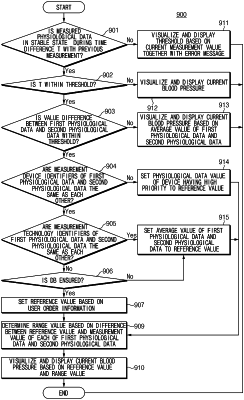| CPC A61B 5/7271 (2013.01) [A61B 5/0004 (2013.01); A61B 5/11 (2013.01); A61B 5/7221 (2013.01); A61B 5/7246 (2013.01); A61B 5/742 (2013.01)] | 16 Claims |

|
1. An electronic device, comprising:
communication circuitry configured to receive data from at least one external device and/or transmit data to the at least one external device;
a display;
a processor operatively connected with the communication circuitry and the display; and
a memory operatively connected with the processor,
wherein the memory stores instructions which, when executed, cause the processor to:
receive, via the communication circuitry, first physiological data and second physiological data obtained by measuring a physiological state of a body of a user, wherein the first physiological data is from a first external device and the second physiological data is from a second external device;
obtain first sensing data associated with the first external device and with a time during which the first physiological data is measured by the first external device, and second sensing data associated with the second external device and with a time during which the second physiological data is measured by the second external device;
determine, based on the first sensing data and the second sensing data, a user state indicating whether the user is in a stable state or in an unstable state during a period of time the first physiological data is measured by the first external device and/or the second physiological data is measured by the second external device;
based on the user determined to be in the stable state during the period, generate integrated data of the first physiological data and the second physiological data based on comparing the first physiological data with the second physiological data;
wherein generating the integrated data includes,
based on a difference between the first physiological data and the second physiological data not being within a threshold value, generate the integrated data based on an average value of the first physiological data and the second physiological data; and
based on the difference between the first physiological data and the second physiological data being within the threshold value, set a value of the first physiological data or the second physiological data to a reference value based on a priority for each of the first physiological data and the second physiological data, determine a range value for the reference value based on a difference between the reference value and a measurement value of each of the first physiological data and the second physiological data, and generate the integrated data based on the reference value and the range value; and
control the display to display the integrated data changing with time.
|